Anquan 安全
Introduction
This section pulls academic articles from Chinese universities and organizations that explore the sophistication of the technology being used to monitor ethnic minority populations. Many of these articles have been submitted to computer science and electrical engineering conferences and journals outlining the process for creating and maintaining such surveillance systems. Some of these papers have been written in collaboration with the Xinjiang Police College, government ministries, and other institutions throughout China. These scholarly works provide insight into the importance of surveillance to the Chinese state and offer an understanding of the range of systems deployed on local populations. Such articles are important to document because they explain the array of algorithms and code used to develop these systems as well as the importance academic institutions, governing bodies, and security agencies have placed on collecting data and information of PRC citizens.
This pervasive system of surveillance expands all over the country and has been used for particularly nefarious reasons in Xinjiang. Non-Han people often become subjects of scientific studies and their physical data is harvested in the name of arthrometric or medical aesthetical studies (see Ai et al 1996, 2001; Cui et al 2005; Ge et al 2007). This research reflects scientific racism in China in which non-Han people, such as Uyghurs and Kazakhs, bear explicit physical differences from Han people. Such ideology and problematic data collection could preclude today’s mass biodata collection in Xinjiang. The PRC has continually invested in the development of their surveillance infrastructure funding companies like Hikvision and Dahua with million-dollar contracts as seen in Figure 1. This is the case for cities like Chongqing which has one CCTV camera for every 6 residents and Sanmenxia, which used facial recognition technology on its residents to determine whether or not they were Uyghur over 500,000 times one month. The tech-research website Comparitech found that out of the top 20 most surveilled cities in the world, 16 of those cities were located in China. As of May 2021, out of the 770 million CCTV cameras in the world, 54% of those cameras are located in China.
The term anquan (Ch. safety, security, 安全, 公共安全), in Chinese academic discourse revolves around social stability, social management, population control, security, and surveillance technologies. In Xinjiang’s context, it is used to surveil non-Han people and keep them in check, all in the name of public security. This belief that non-Han people must be closely monitored stems from Han-centric, racial ideology and is used to justify scientific research and categorization of Turkic people’s Eurasian facial features. Anquan (安全) is different from stability discourse (稳定), although there is some overlap in regard to the fight against terrorism. Stability (稳定) focuses more on issues related to territorial integrity and social stability, like maintaining the Party’s central authority, but anquan (安全) is particularly close to invasive surveillance in the name of security.
Many articles have been written about the massive surveillance state that has recently dominated the region. Reports of highly sophisticated facial recognition software, placing scannable QR codes on the homes of minority populations in the region, police checkpoints requiring ID scans, and the massive collection of biometric data has become the reality for those living in Xinjiang.
Figure 1: This IPVM infographic shows the $1.2 billion dollars in spending on surveillance technologies in Xinjiang between 2016 to 2017.
These articles have come under intense scrutiny from the international and academic community. Questions of consent and ethics arose with the publication of these studies, as many of the individuals who participated may have not been properly informed. Much of this biometric information was collected years ago and for a different purpose, reusing these samples for different studies without the informed consent of the individuals is unethical. With the more recent samples, human rights groups’ worry data was forcefully taken by authorities as opposed to offered by volunteers. The larger fear is that these systems contribute to the mass persecution of minority populations in Xinjiang and the over-collection of data about them. Since the publication of this work, eight members of the editorial boards of these journals have resigned over the controversy surrounding these articles, highlighting the need for oversight regarding what gets published.
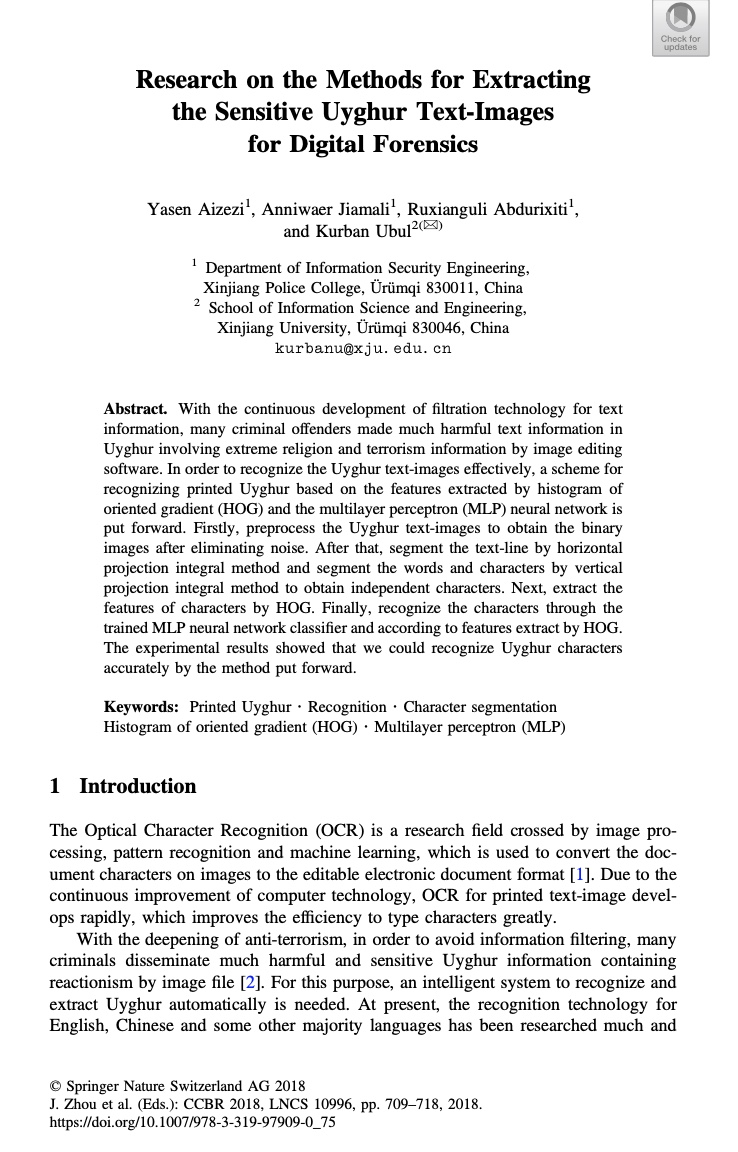 |
Xinjiang Police College and Xinjiang University, 2018Research on the Methods for Extracting the Sensitive Uyghur Text-Images for Digital ForensicsIn partnership with Xinjiang University and Xinjiang Police College, researchers focused their study on learning how to identify Uyghur text within images. Central to this research was the belief that “many criminal offenders made much harmful text information in Uyghur involving extreme religion and terrorism information” (page 706). Current technologies are able to accurately recognize both English and Chinese language however because Uyghur is an agglutinative language it is unidentifiable in these systems. Researchers leveraged histogram of oriented gradient (HOG) and multilayer perceptron (MLP) neural networks to create a four-step process for identification. The experiment used four pictures from Uyghur magazines including 528 words and 1760 characters as well as a standard Uyghur character library. With the new identification process outlined by the researchers (HOG + MLP), there was a 96.15% correct recognition rate. This emerging focus on Uyghur script in digital forensics highlights the perceived need for encompassing surveillance on this population. |
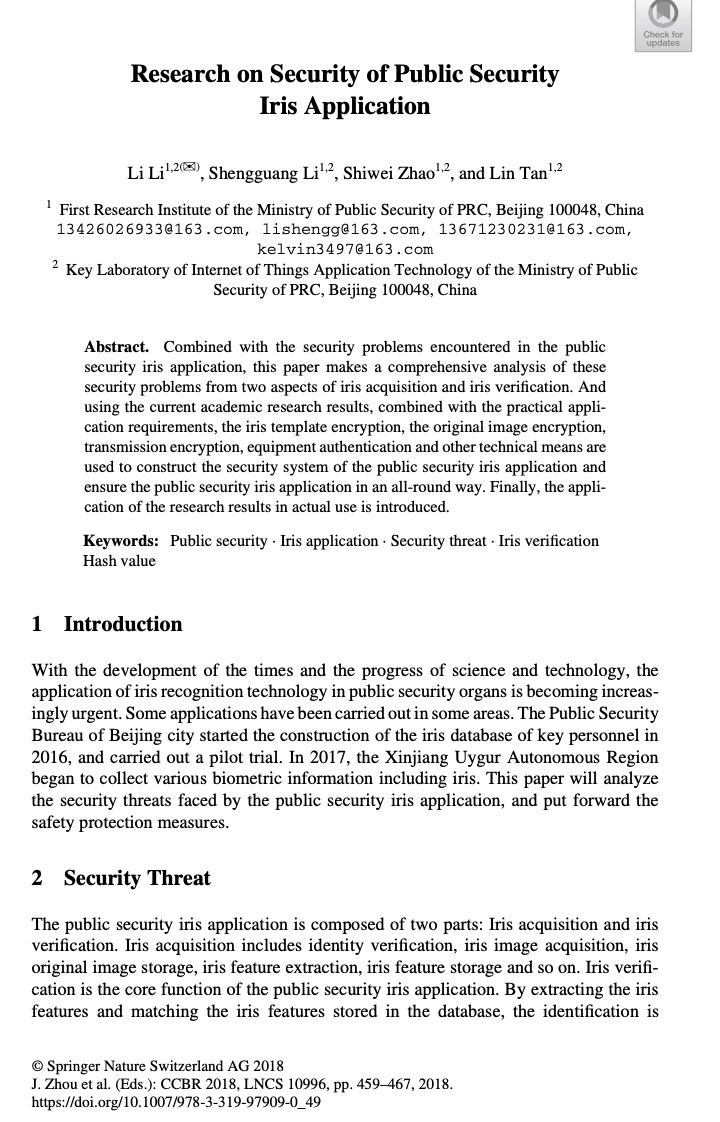 |
The Ministry of Public Security of PRC, 2018Research on Security of Public Security Iris ApplicationAs outlined at the beginning of the research study, by 2017 Xinjiang had ushered in a variety of biometric data collection techniques, including iris scanning for monitoring local populations. With the widespread adoption of this technology, there was a need for a system sophisticated enough to house “hundreds of billions of iris original images” as well as have the ability to safeguard the information (page 463). The application essentially scans the iris for features and then those identified features are matched in a pre-established, continually growing archive of images. This study explores potential threats to the iris scanning system in both the acquisition and verification process while suggesting solutions to counterattacks on the system. This piece recognizes the proliferation of iris scanning throughout China and offers insight into the importance of protecting this data from outside interference or attack. |
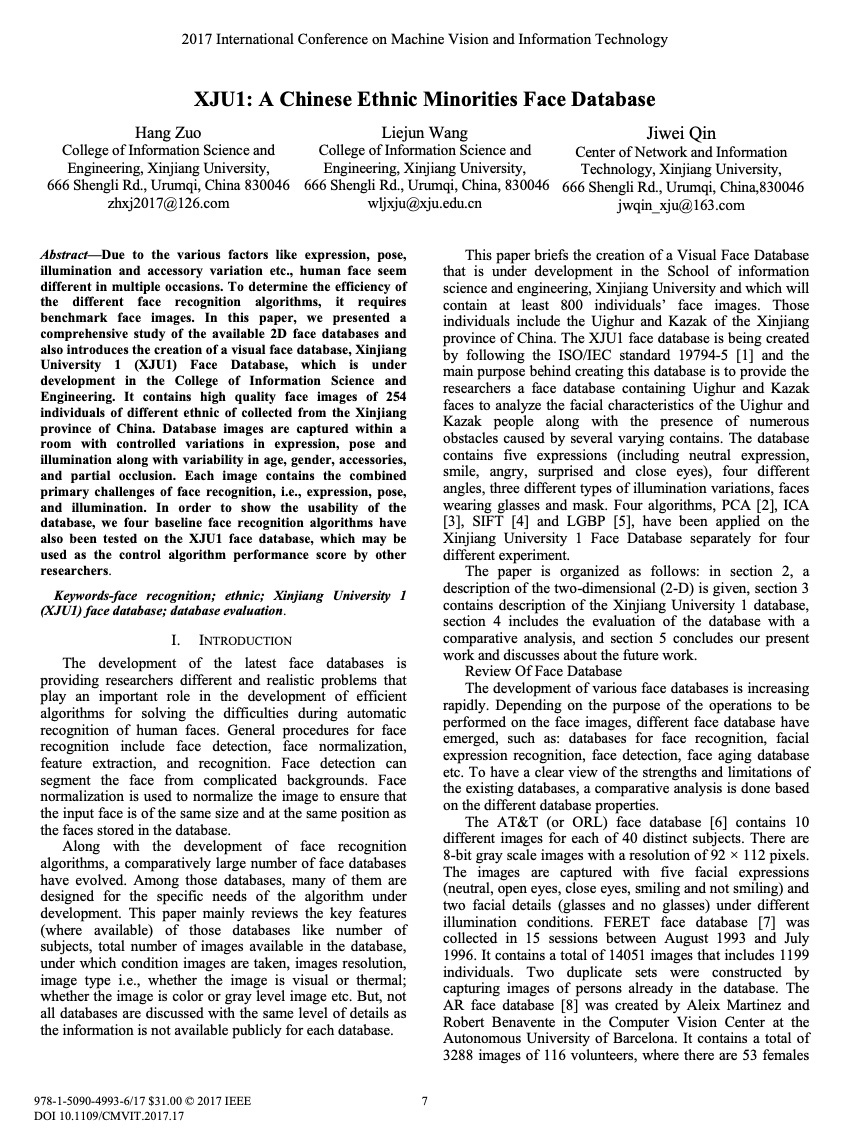 |
Xinjiang University, 2017XJU1: A Chinese Ethnic Minorities Face DatabaseThis article outlines the process used to create a new facial recognition database, XJU1, and its ability to differentiate between ethnic groups in the Xinjiang region. The project used four different algorithms (PCA, ICA, SIFT, and LGBP) to see which was most successful in identifying faces. These algorithms accounted for different ways to identify people including but not limited to posture, eye colour, and varying backgrounds. Ultimately the database created in Xinjiang used at least 800 individual faces containing, “five expressions, four different angles, three different types of illumination variations, faces wearing glasses and mask” (page 7). This database was created with the expressed interest of identifying Uyghur and Kazakh faces. As stated in the article, “the XJU1 face database is mainly constituted of Chinese Uighur ethnic groups and Kazak national. It contains 7683 images of 197 persons from Uighur ethnic groups and 2223 images of 57 Kazak national” (page 9). Ultimately LGBP was the most successful algorithm with a 93% correct identification rate. This report alludes to the importance educational institutions and government agencies have placed on the identification and tracking of ethnic minority groups throughout the region. Since its publication, the Institute of Electrical and Electronics Engineers (IEEE) issued an expression of concern, however, they did not retract the article. |
 |
Xinjiang University and Xinjiang Police Institute, 2016Uyghur Off-line Signature Recognition Based on Modified Corner Curve FeaturesXinjiang University and the Xinjiang Police Institute collaborated on this research project to pilot a new signature recognition application for Uyghur script. Presently, handwritten signatures are one of the most commonly accepted biometrics for human identity recognition and verification. For this study, 380 Uyghurs provided 21 samples of handwriting per person. This multistep project used two forms of signature recognition (online and offline), two experiments (Euclidean distance classifier and non-linear SVM classifier), and two identification methods (corner curve features and modified corner curve features) on the 7980 handwriting samples provided by participants. Ultimately using the modified corner curve feature and the non-linear SVM classifier, researchers yielded a 98.9% recognition rate. This study highlights the importance the police force in Xinjiang places on the tracking of all aspects of Uyghur communication and identification. |
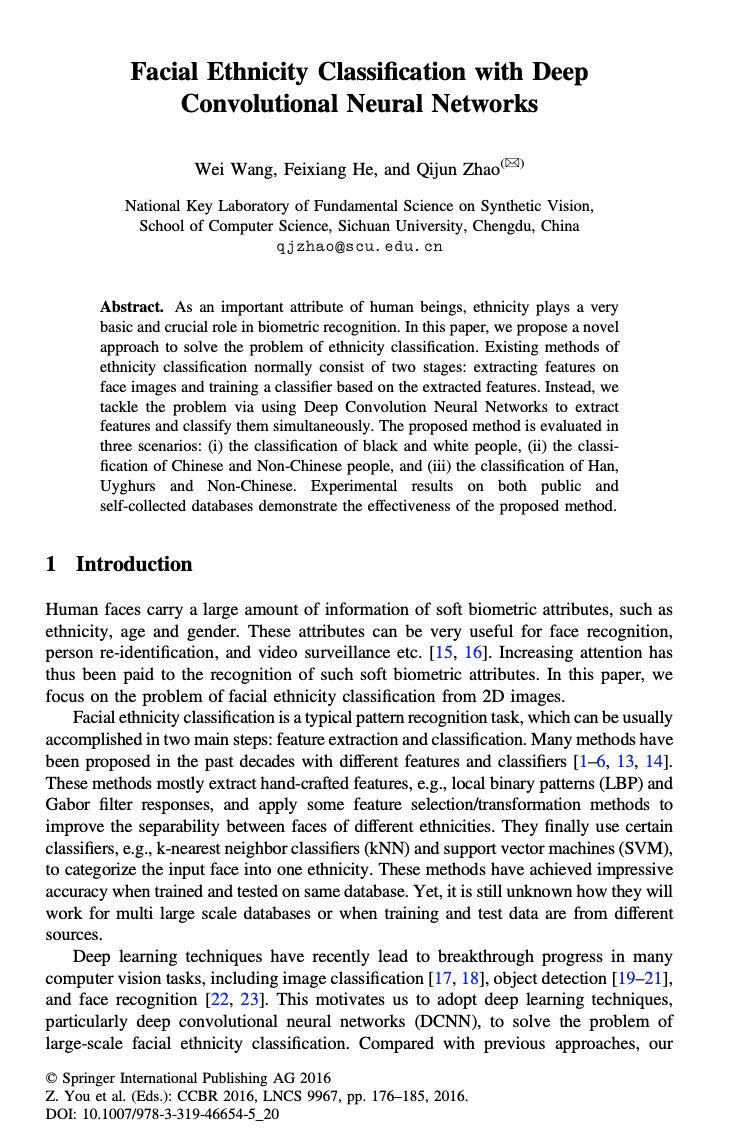 |
Sichuan University, 2016Facial Ethnicity Classification with Deep Convolutional Neural NetworksThis paper proposes an innovative solution to traditional facial classification via the usage of deep convolution neural networks. This solution expedites the classification process by using a 5 layer network architecture to streamline the categorization of ethnicity. The researchers tested this solution on three different scenarios: classification of White and Black people; of Chinese and Non-Chinese people; and of Han, Uyghur, and Non-Chinese people. For the first two scenarios researchers used publically available datasets, however for the classification of Han, Uyghur, and Non-Chinese faces the researchers used private facial databases from CCTV cameras from railway stations and shopping malls. It is unclear whether or not the researchers had informed consent from this group to use their biometric information. Results varied but overall the researchers had a 99% recognition rate for all groups. This research highlights the normalization of mass biometric data collection, specifically of CCTV cameras, and alludes to the collaborative nature of governments and academic institutions in sharing this data to accelerate studies on facial ethnicity classification. |
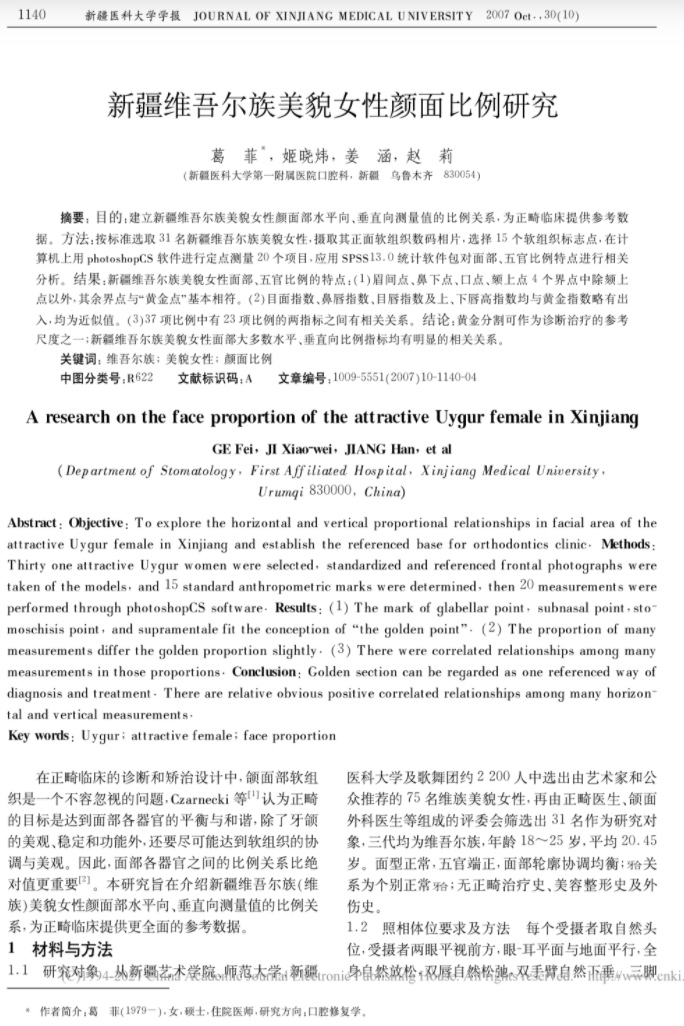 |
Journal of Xinjiang Medical University, 2007A research on the face proportion of the attractive Uygur female in XinjiangThis study is based on measurements of 31 attractive Uyghur women’s horizontal and vertical proportional relationships in facial areas in order to establish the referenced base for orthodontics clinic. |
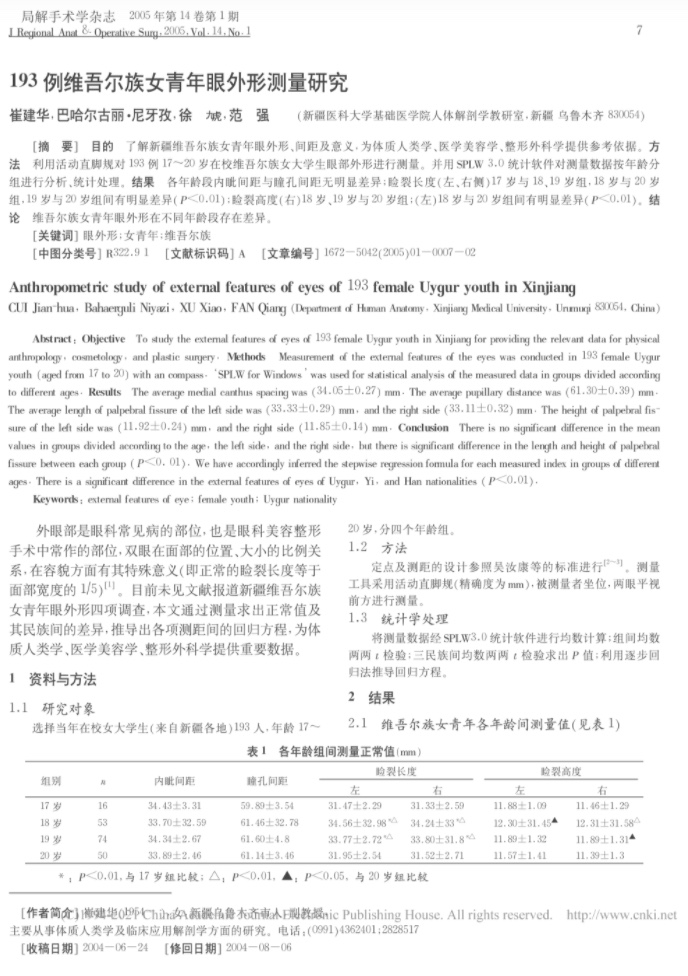 |
Journal of Reginal Anatomy and Operative Surgeon, 2005Anthropometric Study of External Features of Eyes of 193 Female Uygur Youth in XinjiangThis study focuses on the eye feature of Uyghur women to provide relevant data for physical anthropology, cosmetology, and plastic surgery. |
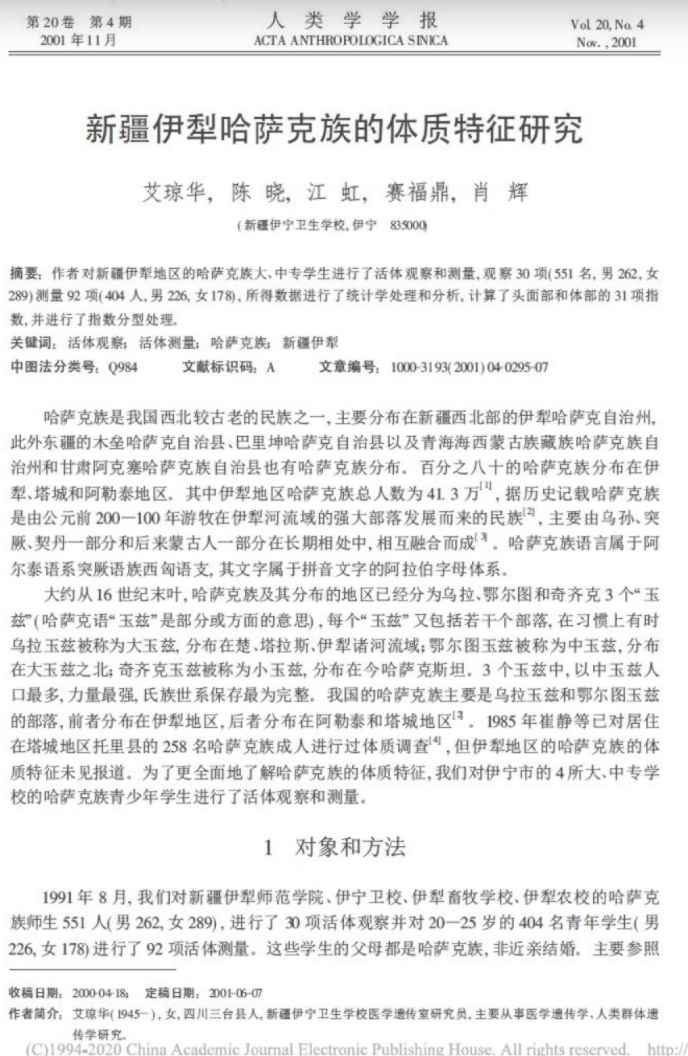 |
Acta Anthropologica Sinica, 2001A Study on Physical Characteristics of Kazaks in Yili of XinjiangA survey on anthropometry of 404 Kazak students in Yili studying their hair, facial features, and statures. |
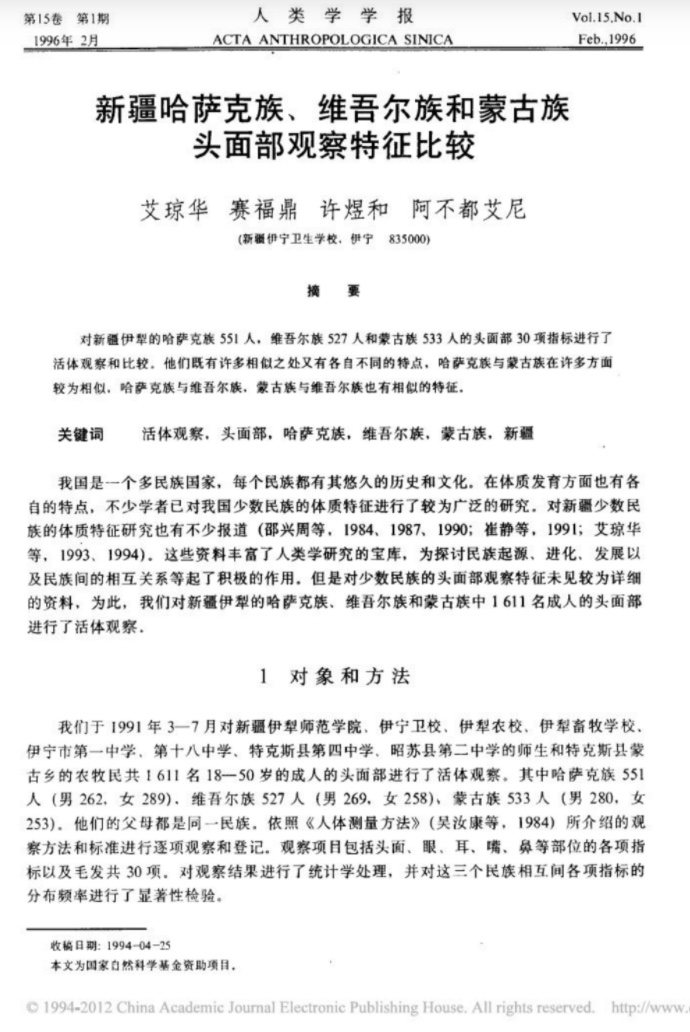 |
Acta Anthropologica Sinica, 1996Comparison of Head and Facial Features Among Kazaks, Uigurs, and Mongols.The study examines the somatoscopy of the head and facial features of Kazakh, Uyghur, and Mongol in Xinjiang. |
References
Bischoff, P. (2021, May 17). Surveillance camera Statistics: Which cities has the Most CCTV Cameras? Comparitech. Retrieved from https://www.comparitech.com/vpn-privacy/the-worlds-most-surveilled-cities/.
Campbell, C. (2019, November 21). “The Entire System is Designed to Suppress Us.” What China’s surveillance means for the rest of the world. Time. Retrieved from https://time.com/5735411/china-surveillance-privacy-issues/.
Chan, T. F. (2018, July 31). How a Chinese region that accounts for just 1.5% of the population became one of the most intrusive police states in the world. Business Insider. Retrieved from https://www.businessinsider.com/xianjiang-province-china-police-state-surveillance-2018-7.
Chin, J., & Bürge, C. (2017, December 20). Twelve days In Xinjiang: How China’s Surveillance State Overwhelms daily life. The Wall Street Journal. Retrieved from https://www.wsj.com/articles/twelve-days-in-xinjiang-how-chinas-surveillance-state-overwhelms-daily-life-1513700355.
Hvistendahl, M. (2021, August 4). Mass resignations at scientific journal over ethically fraught China genetics papers. The Intercept. Retrieved from https://theintercept.com/2021/08/04/dna-profiling-forensic-genetics-journal-resignations-china/.
Lehr, A. (2021, July 27). Responding to the Xinjiang Surveillance State- and Its Likely Progeny. Center for Strategic & International Studies. Retrieved from https://www.csis.org/analysis/responding-xinjiang-surveillance-state-and-its-likely-progeny.
Mozur, P. (2019, April 14). One month, 500,000 Face Scans: How China is using A.I. to profile a minority. The New York Times. Retrieved from https://www.nytimes.com/2019/04/14/technology/china-surveillance-artificial-intelligence-racial-profiling.html.
Normile, D. (2021, August 10). Genetic papers containing data from China’s ethnic Minorities draw fire. Science. Retrieved from https://www.science.org/news/2021/08/genetic-papers-containing-data-china-s-ethnic-minorities-draw-fire.
Richardson, S. (2017, May 15). China: Police Dna Database threatens privacy. Human Rights Watch. Retrieved from https://www.hrw.org/news/2017/05/15/china-police-dna-database-threatens-privacy.
Rollet, C. (2018, April 23). Dahua and Hikivision win over $1 Billion in Government-Backed Projects In Xinjiang. IPVM. Retrieved from https://ipvm.com/reports/xinjiang-dahua-hikvision.
Rollet, C. (2018, July 16). Hikvision Wins Chinese Government Forced Facial Recognition Project Across 967 Mosques. IPVM. Retrieved from https://ipvm.com/reports/hik-mosques.
Van Noorden, R. (2020, November 18). The ethical questions that haunt facial recognition research. Nature News. Retrieved from https://www.nature.com/articles/d41586-020-03187-3.
Wang, M. (2020, August 3). “Eradicating ideological viruses” China’s Campaign of Repression Against Xinjiang’s Muslims. Human Rights Watch. Retrieved from https://www.hrw.org/report/2018/09/09/eradicating-ideological-viruses/chinas-campaign-repression-against-xinjiangs.
